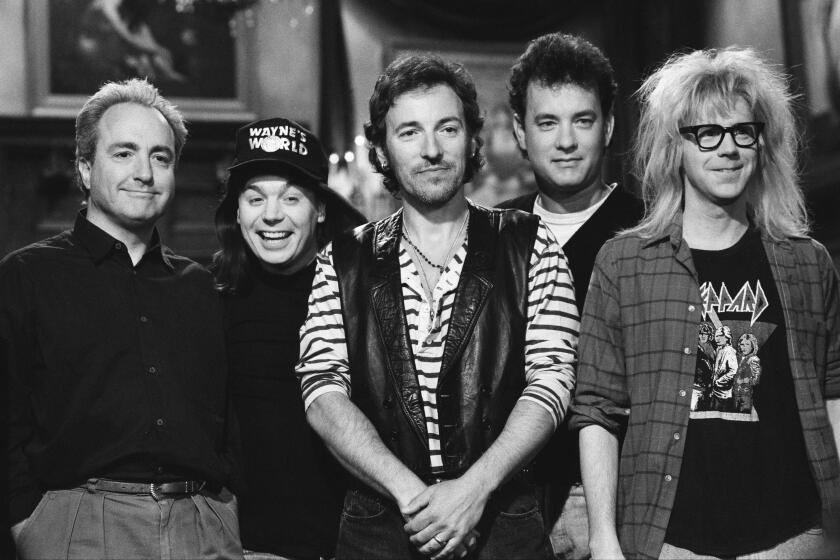AMERICA’S PRISONER: The Memoirs of Manuel Noriega.<i> By Manuel Noriega and Peter Eisner</i> . <i> Random House: 293 pp., $25</i>
- Share via
Mussolini didn’t bother to write a memoir; he went right for the novel and did a pretty competent job of it with “The Cardinal’s Mistress,” a book my father bought because of its racy title. Hitler didn’t bother with reminiscence either--instead he produced his obsessive, plot-driven “Mein Kampf.”
Now it’s Panamanian dictator Manuel Noriega’s turn to soften his malevolent image as a villain and Third World buffoon. It’s been seven years since a staggering force of 20,000 American troops invaded Panama and brought down the dictator. Like a fox, Noriega took to the hills, even earning the support of the Vatican at one point, before being caught and extradited to the United States on charges of trafficking in Colombian cocaine. It was the end of Noriega’s long and stormy relationship with the United States, during which Noriega functioned as an ally, an operative and a dupe for Washington.
In 1992, Noriega was convicted on eight counts of drug trafficking, racketeering and money laundering and is now serving a 40-year sentence at a federal prison in Miami. A convicted drug trafficker--Luis Santacruz Echeverri--helped secure a conviction against Noriega by convincing Ricardo Bilonick, a former Panamanian diplomat, airline owner and convicted drug trafficker, to testify. In his testimony, Bilonick said that the general had allowed him to ship tons of cocaine to the United States from Panama in the 1980s.
The dictator now lives in a windowless three-room suite with a small private outdoor exercise area featuring an Exercycle on which he pedals daily. He watches TV and he spends time on the telephone with family and friends. One might say it was an excellent environment in which he might gather his thoughts and write his memoirs, albeit assisted by Peter Eisner, who recorded hours of interviews with Noriega in Noriega’s suite. However, time and applying oneself do not make a good book: “America’s Prisoner” reads like a list of well-documented complaints, sans reflection, sans intimacy, sans the personal.
Perhaps it suffers in translation--there is none of the natural exuberance of the Spanish language, none of the color or original turn of phrase. There is on occasion a bit of gossip. Noriega, for example, reminisces about the wife of Shah Mohammed Reza Pahlavi of Iran, Farah Diba, who went water-skiing one afternoon. The shah at the time had been given refuge in Panama. “One day,” Noriega writes, “there was a ruckus among the security guards--the scuba diving team, to be exact--because they spotted her water-skiing in the Pacific. The divers got as close as they could and enjoyed the view; she was a very attractive woman.”
Leaving Diba and her beauty aside, this memoir, when it decides to address the many charges that Noriega ran his government like a bloodthirsty mobster, is evasive and assumes that readers can be easily fooled. For instance, Noriega has been accused of complicity in the death of Hugo Spadafora, a doctor and former vice minister of public health who had publicly accused him of being a tyrant and a drug trafficker. Spadafora had first made the accusation to officers of the Drug Enforcement Administration. In “America’s Prisoner,” Noriega gives this terse account of Spadafora: “On the morning of September 16th, 1985, the news from home was a shock: Hugo Spadafora had been found murdered over the weekend in Chiriqui. I was out of the country in Europe for several weeks, attending a military-naval-affairs conference, and traveling between England, Paris and Switzerland.” Later, he excuses himself: “This series of events occurring in my absence gave rise to a web of lies.” Yet according to the National Security Agency, Noriega may have been in Paris, but he kept in touch by phone. The NSA monitored a conversation between Major Luis Cordoba (Chiriqui was his province) and Noriega, part of which went as follows:
Cordoba: “We have the rabid dog.”
Noriega: “And what does one do with a dog that has rabies?”
Noriega considers himself a man of honor and dignity, a man who can say no when he feels his dignity and honor are being compromised. When Oliver North wanted his help in Nicaragua, Noriega said no; he considered the Contra war a losing battle and he wanted no part of it. When the CIA wanted a 15-year extension in the operation of the School of the Americas, a training ground for death squads and repressive right-wing militaries, Noriega said no. He said no again to Nicholas Ardito Barletta’s bid to remain president of Panama. This last refusal, however, proved to be his undoing; Barletta, who was a former student of George Shultz at the University of Chicago, was President George Bush’s choice for president. For Noriega, it was three no’s and you’re out; Noriega didn’t realize that he had cooked his own goose and had lost his place at the table.
On Dec. 20, 1989, Bush launched “Just Cause,” a surprise attack on Panama. Many people were killed and injured in this operation, and Noriega, who had been hiding in the papal residence, the nunciature (it is claimed he slept with his “teddy bear,” a machine gun), was taken away on Jan. 3 by United States forces to Miami to stand trial.
There are many names, events and dates to take note of in “America’s Prisoner” and many interpretations of Noriega’s relationship with the United States, the CIA, Bush and North. As Noriega says: “ . . . I recall what an acquaintance, businessman Roberto ‘Papa Bobby’ Motta, said to me: ‘Tony, there are three kinds of truth in the world--your truth, my truth, and the truth.’ ”
When one looks into Noriega’s world, one finds many versions of the truth. Some stories about Noriega present a picture of the very bizarre world of this deposed dictator, but in “America’s Prisoner,” you will find no mention of the widely reported stories that circulated at the time of his capture. What about the cocaine and the pornography soldiers took from his residence? What about the Brazilian voodoo witches who performed rituals for Noriega’s protection? What about the witch house with its 50 pounds of cocaine, a bucket of blood and various voodoo artifacts? And on a milder but no less interesting note, what of Noriega’s conversion from Catholicism to Buddhism?
One won’t find the answers by reading this book. This book is Noriega’s attempt to set the record straight and to attach (figuratively speaking) electrodes to sensitive parts of George Bush’s anatomy. And why shouldn’t he want to do damage? Hasn’t he been used and then thrown away? But what ultimately emerges--the primary truth, it seems, behind Noriega’s venture into autobiography--is the hope that it will profit him in more ways than one. The pen is mightier than the sword, but can it rewrite history? Not in this account.
Nevertheless, a greater truth still lies ahead when the sales figures are brought forth: It will be greeted with either lamentation or rejoicing from the publisher. No matter; when the former dictator, in his respectable guise as author, remounts his stationary bicycle, adjusts the resistance, checks his pulse and begins to pedal, he will still be going nowhere fast.
More to Read
Sign up for our Book Club newsletter
Get the latest news, events and more from the Los Angeles Times Book Club, and help us get L.A. reading and talking.
You may occasionally receive promotional content from the Los Angeles Times.










